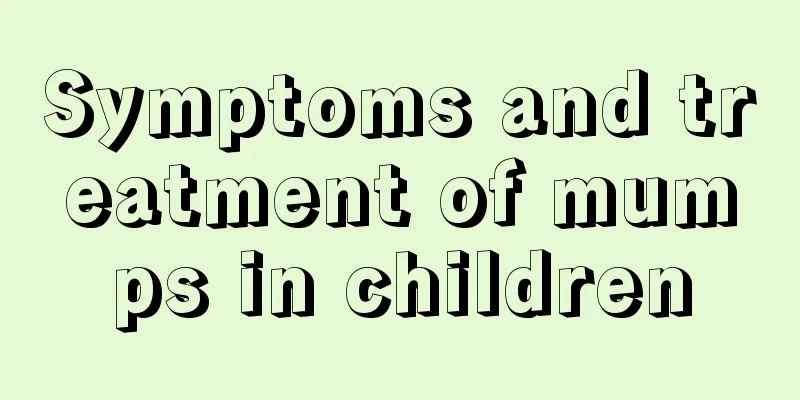Symptoms and treatment of mumps in children

|
The neighbor's child recently found that both sides of his face were red and swollen, and he was also running a fever. The usually lively and cute child now looks listless and pitiful. It's been several days and there's no improvement. I went to the hospital for treatment and the doctor said it was mumps and it would take at least a week to recover. So what are the symptoms and treatments of mumps in children? Let us learn about it below. 1. Incubation period 2 to 3 weeks, 18 days on average. 2. Prodromal manifestations The prodromal phase is very short, ranging from a few hours to 1 to 2 days. Common symptoms include fever, loss of appetite, general weakness, headache, vomiting, etc. A small number of children may develop meningitis in the early stages and may experience meningeal irritation signs. 3. Parotid gland swelling stage The parotid gland swells first on one side and then on the other side. There are also cases where only one side swells or there is no swelling of the parotid gland. The swelling is characterized by being centered on the earlobe, expanding toward the surrounding area, with unclear edges, elasticity and tenderness to the touch, and no redness on the surface of the skin. The upper edge of the swelling can reach the zygomatic arch, the posterior edge reaches the sternocleidomastoid muscle, and the lower edge extends to the submandibular area and the neck. The cheek swelling reaches its peak in about 3 to 5 days, then gradually shrinks and generally disappears in about a week, occasionally lasting up to 2 weeks. Sometimes both the submandibular gland and the sublingual gland may swell, with the former being more common. In some cases, only the submandibular gland is enlarged while the parotid gland is not. In some children, the submandibular gland, sublingual gland and parotid gland may never have obvious swelling, and may only show signs of viremia or complications. Redness and swelling may be seen at the opening of the parotid duct. The child feels local distension and hyperesthesia in the parotid gland, which is more obvious when opening the mouth and chewing. The body temperature remains high while the parotid glands are swollen, but the degree of temperature increase and the duration of temperature increase have nothing to do with the degree of parotid gland swelling. The duration of fever varies, ranging from 1 to 2 days in the shortest case to up to 2 weeks in the rarest case. Moderate fever is more common, while low-grade and high-grade fever are rare. About 20% of the body temperatures remain normal. diagnosis When there is obvious swelling of the parotid gland and a clear history of contact, it is not difficult to make a clinical diagnosis if other causes of parotid swelling are excluded. In cases of simple submandibular or sublingual gland enlargement, the diagnosis can be made if there is a clear source of infection and local lymphadenitis is excluded. Clinical diagnosis is difficult in cases where encephalitis occurs before or without parotid gland swelling. The peripheral blood leukocyte count is mostly normal or slightly increased, and the lymphocyte count is relatively increased in the classification examination. Blood and urine amylase levels are mild to moderately elevated, but need to be differentiated from pancreatitis. Serum lipase determination is helpful in diagnosing pancreatitis. Those suspected of having meningitis may undergo a cerebrospinal fluid examination, but if the symptoms are obvious and the diagnosis of mumps is clear, there is no need for a cerebrospinal fluid examination, and mild cases do not require special treatment. To make an etiological diagnosis, virus isolation should be performed from blood, saliva, urine and cerebrospinal fluid. Differential Diagnosis 1. Mumps caused by other viruses It is now known that influenza, parainfluenza, adenovirus, enterovirus, etc. can cause mumps. Initial identification can refer to the epidemiological history and clinical symptoms, and the final identification method is to conduct etiological and serological examinations. 2. Suppurative parotitis It often recurs multiple times, and all are located in the parotid gland on the same side. Suppurative parotitis should be suspected. Pus can be seen flowing out of the parotid duct opening when the gland is squeezed. The local surface skin is red and swollen, with obvious tenderness, unclear surrounding boundaries, and increased peripheral blood white blood cells and neutrophils. It can occur in children of all ages and disappear naturally during puberty. Sialagogues (such as chewable gummy candies) are used to increase saliva flow, and antibiotics are effective. 3. Parotid gland swelling caused by other reasons (1) In chronic wasting diseases and malnutrition, the parotid gland may swell. It is usually bilateral, with mild swelling, no tenderness, and no heat sensation on the skin. It exists for a long time and is generally not accompanied by symptoms of acute infection. There is no obvious pain or tenderness in the local area. (2) When the salivary duct is blocked by stones, the parotid gland may swell and may be tender, but there are no symptoms of acute infection. The disease is characterized by repeated attacks, sudden swelling of the parotid gland, and rapid subsidence, often on the same side. 4. Regional lymphadenitis Acute lymphadenitis is mostly unilateral case, located under the jaw or chin, the lump is not centered on the earlobe, the lymph nodes are initially enlarged and hard, with clear edges and obvious tenderness, and pharyngeal inflammation is often present. There is no redness or swelling at the parotid duct opening. 5. Other central nervous system infections In cases where encephalitis, meningitis, myelitis, cranial nerve damage, etc. occur before parotid gland swelling, some time after swelling, or without parotid gland swelling, they need to be differentiated from other pathogens, especially other viral central nervous system infections. The diagnosis is usually confirmed by serologic testing. complication Mumps in children is not a serious disease in itself, but it has many complications, some of which are more serious. 1. Neurological complications It is reported that about 10% to 20% of cases may have clinical manifestations, including encephalitis (about 5%), meningoencephalitis (about 27%), and encephalomyelitis. Those with cerebellar lesions mainly present with ataxia; those with lenticular nucleus lesions mainly present with torsion spasms; cranial nerve damage and hydrocephalus may also be seen. The overall prognosis is good, but deaths and sequelae are occasionally seen. Meningoencephalitis may occur before, during, or after parotid swelling. Statistics show that the incidence rate is 1.6% in the 6 to 10 days before swelling, 11% in the 1 to 5 days, 2.5% at the same time as swelling, 20.3% in the 1 to 5 days after swelling, 11% in the 6 to 10 days, and 1.6% in the 11 to 26 days. Specifically, meningoencephalitis may occur two weeks before or after cheek swelling. The main clinical manifestations are fever, headache, vomiting, drowsiness, neck stiffness, and in a few cases, coma and convulsions. Since cerebrospinal fluid examination is generally not performed, the exact incidence and changes in cerebrospinal fluid are difficult to know. It is generally believed that the number of cerebrospinal fluid cells is slightly increased, mostly ranging from dozens to hundreds, and occasionally exceeding 1000×106/L. The classification shows that lymphocytes account for the majority, sugar and chloride are normal, and protein is slightly increased. It takes a long time for cerebrospinal fluid to return to normal, usually 3 to 6 weeks. 2. Reproductive organ complications The mumps virus can also invade the reproductive glands, manifesting as orchitis or oophoritis. The former is more common than the latter, which may be related to the ease of clinical detection. This complication is more common in adolescents or adults and is rare in children. It usually occurs 3 to 13 days after parotid gland swelling, and is more common on one side, with only 2% to 3% occurring on both sides. Clinical manifestations include high fever, headache, nausea, vomiting, and local pain. Swelling of the scrotum and redness of the skin. The course of the disease is about 10 days. The incidence of oophoritis is less than that of orchitis, and the clinical symptoms are also mild, with only lower back pain, tenderness in the lower abdomen, and menstrual disorders. It can cause about 30% to 50% of the testicles or ovaries to undergo varying degrees of atrophy, and bilateral atrophy can lead to infertility. 3. Acute pancreatitis It can be seen in older children, and most cases occur 3 to 5 days to 1 week after parotid swelling. The main symptoms are a sudden rise in body temperature, accompanied by repeated and frequent vomiting, severe upper abdominal pain, diarrhea, abdominal distension or constipation. There is obvious tenderness in the upper abdomen, local muscle tension, and B-ultrasound sometimes shows an enlarged pancreas. Blood and urine amylase levels are elevated, but in 90% of simple mumps cases, amylase levels may also be slightly or moderately elevated. Serum lipase determination is helpful in the diagnosis of pancreatitis. In recent years, amylase isoenzymes have been measured to distinguish between parotid gland (P type) and salivary gland (S type) amylase. 4. Sensorineural hearing loss Hearing loss and even deafness are also complications and sequelae of mumps, and there have been reports of this both at home and abroad. This change is not only seen in patients with concurrent encephalitis, but also in children with simple mumps. It has been observed that deafness mostly occurs on one side, with a higher incidence in older children, and most cases occur within 10 days of onset. If concurrent with encephalitis, the incidence of deafness is even higher, about 23.8%. Deafness caused by auditory nerve edema can be recovered in about 6 months by reducing edema and improving local microcirculation. However, deafness caused by degeneration of the auditory nerve often becomes a lifelong damage. 5. Other complications The incidence of mumps complicated by nephritis is about 1.14%, which may occur at the same time as parotid swelling or within 1 week of mumps. In addition to the symptoms of mumps, there may also be low back pain, frequent urination, oliguria, hematuria, eyelid and lower limb edema, and hypertension. Urinalysis showed varying degrees of proteinuria and hematuria. Renal function is mostly normal or temporarily reduced. As mumps improves, the inflammation of nephritis also eases and generally recovers within 3 weeks. Sometimes the virus can be detected in the urine, suggesting the possibility of direct kidney damage by the virus. About 2% to 4% of children with mumps develop myocarditis and pericarditis. The clinical symptoms are mild, and various types of arrhythmias and ST-T changes can be seen on the electrocardiogram. Most patients recover within a few days, but a few severe cases may develop heart failure. There have also been reports of cases of Adams-Stokes syndrome. The concurrent hepatitis rate is approximately 1.25%. There are also a few cases of concurrent arthritis, which often affects large joints, and the symptoms usually disappear within 3 months. In addition, platelets decreased by approximately 2.6%. There are also mastitis, lacrimal gland inflammation, presternal soft tissue edema, facial nerve paralysis, gastrointestinal bleeding and epidemic hemorrhagic fever. I believe everyone has a certain understanding of the symptoms and treatments of mumps in children. Having mumps is not scary. Although the treatment is long, as long as parents pay attention to letting their children stay at home and get more rest, give them more rice porridge and other light, easy-to-chew and easy-to-digest foods, and avoid letting them eat sour, spicy and other irritating foods. The child will definitely get better soon. |
<<: What's wrong with a five-year-old baby's astigmatism?
>>: Why is the child born with a hoarse voice?
Recommend
How to educate a willful child?
Generally speaking, most children are willful bec...
Newborn hiccups after waking up
It is quite common for newborns to hiccup after w...
Can babies take zinc supplements during a cold?
Baby cold is a relatively common disease. If the ...
Six month old baby loves to stick out tongue
After ten months of pregnancy, the most important...
What medicine should I use for my baby's itchy skin?
The baby's skin is very delicate. If skin itc...
What is the normal range of blood test in children?
A routine blood test is the most basic blood exam...
Newborn baby's head is big
I believe that many parents have encountered such...
What should I do if my two-year-old child has diarrhea?
Diarrhea is a very common problem for babies. The...
There is red blood clot in the newborn's eyes
If there are red blood clots in the eyes of a new...
Why does my child's tongue hurt?
Traditional Chinese medicine can observe a person...
How to strengthen the physical fitness of children who are prone to catching colds?
It is a common situation for children to have poo...
What are the symptoms of eczema in children? Parents' Information
Eczema is a common skin disease. The incidence of...
What should I do if my two-month-old baby has poor appetite?
It is a very common phenomenon that babies of two...
Is pediatric massage useful? See the expert's explanation
Many people have heard of massage as a treatment ...
Is height inherited from the father or the mother?
Nowadays, parents are more concerned about whose ...









